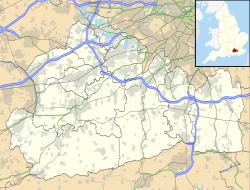Keogh Barracks
| Keogh Barracks | |
|---|---|
| Mytchett, Surrey | |
 Entrance to Keogh Barracks | |
 Keogh Barracks Location within Surrey | |
| Coordinates | 51°16′45″N 0°43′03″W / 51.2793°N 0.7176°WCoordinates: 51°16′45″N 0°43′03″W / 51.2793°N 0.7176°W |
| Type | Barracks |
| Site information | |
| Owner | Ministry of Defence |
| Operator | |
| Site history | |
| Built | 1938 |
| Built for | War Office |
| In use | 1938–Present |
Keogh Barracks is a military installation on Mytchett Place Road, Mytchett, Surrey, England.
History[]
The barracks were commissioned to accommodate the Army School of Hygiene[1] and are named after Sir Alfred Keogh, a former Director-General of Army Medical Services.[1][2] The foundation stone for the main building was laid by Lieutenant General Sir James Hartigan, Director-General of Army Medical Services, in February 1938.[3] The Museum of Military Medicine has its origins in the "Mytchett Collection", a collection of documents accumulated there since 1952.[4] In 1954 the RAMC Field Training Centre took over administration of the barracks.[5] The depot of the Royal Army Medical Corps arrived from Queen Elizabeth Barracks, Church Crookham in 1964[6] and the Field Training Centre subsequently became known as the Royal Army Medical Corps Training Centre.[7]
By the 1990s the Royal Army Medical Corps Training Centre had changed its name to the Army Medical Services Training Group.[8] The Army Medical Services Training Group amalgamated with the equivalent organizations in the Royal Navy and the Royal Air Force to form the Defence Medical Services Training Centre at Keogh Barracks in 1996.[9] However it moved to Whittington Barracks as the Defence College of Healthcare Education and Training in 2014.[10] A major refurbishment costing £50 million was carried out at Keogh Barracks in order to accommodate 4 Armoured Medical Regiment in 2015.[11]
Current units[]
- 2nd Battalion, Ranger Regiment[12]
- 22 Field Hospital, Royal Army Medical Corps[13][14]
References[]
- ^ a b "Keogh, Sir Alfred Henry (1857 - 1936)". Parr's Lives of the Fellows. Retrieved 7 December 2019.
- ^ "RAMC Reunited Newsletter November 2015" (PDF). Retrieved 7 December 2019.
- ^ "Two photographs of the laying by Sir James Hartigan, DGAMS, of the foundation stone of the Sandhurst Block of Keogh Barracks, Mytchett, Surrey, on 17 February 1938". Wellcome library. Retrieved 7 December 2019.
- ^ "Royal Army Medical Corps Muniments Collection". AIM 25. Retrieved 7 December 2019.
- ^ Ahern, Colonel T. M. R. (1 July 1958). "The Field Training Centre" (PDF). Journal of the Royal Army Medical Corps. Retrieved 7 December 2019.
- ^ "ASU Building, QE Barracks, Church Crookham" (PDF). Oxford Archaeology. p. 3. Retrieved 3 June 2018.
- ^ "First Aid Training: An Appraisal. The Soldier's Longest Journey" (PDF). Journal of the Royal Army Medical Corps 1991; 137: 27-30. Archived from the original (PDF) on 28 February 2019. Retrieved 7 December 2019.
- ^ "Flag Lowering Ceremony". Queen Alexandra's Royal Army Nursing Corps. Retrieved 7 December 2019.
- ^ "Memorandum submitted to the Defence Committee by the Ministry of Defence responding to the Committee's Questions on the Defence Medical Services". Hansard. Retrieved 7 October 2018.
- ^ "£138m UK defence medical training hub opens". Government Opportunities. 12 May 2014. Retrieved 7 October 2018.
- ^ "£50 Million Refurbishment At Keogh Barracks". Forces Network. 24 June 2015. Retrieved 7 December 2019.
- ^ "Future Soldier Guide" (PDF). 25 November 2021. p. 70. Retrieved 9 December 2021.
- ^ "22 Field Hospital". www.army.mod.uk. Retrieved 2020-07-15.
- ^ Cooper, Tim (10 December 2015). "HRH Prince William Awards Military Medics Operational Medals". Forces Network. Retrieved 2020-07-15.
- Barracks in England
- Installations of the British Army
